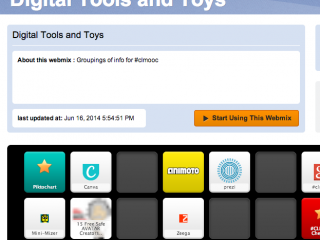How do you curate the huge volume of information that comes through your daily lives?
To curate is to make a special collection of things that shows why they are useful; it is to oversee a collection of works or information, making choices about what it will include and guiding people so they can enjoy it
Curation, it might be argued, has always been an essential practice as a means to stay informed. In today’s Internet-powered age, curation is proving to be an essential literacy skill.
For this make, we are asking you to curate something. It could be a topic you are especially interested in like rare birds, an event like a conference or a tweetchat, a community like CLMOOC, or something else.
Here are some resources that can be useful in curation. There are many more, and you can also curate non-digitally in albums or scrapbooks.
- Symbaloo is a tool that allows bookmarking of a large number of links. Links are identified by icons; text may be added. Symbaloo is less like a Pinterest board, more like an app screen on the web.
- Storyify – allows you to bring in tagged content from Twitter, Facebook, YouTube, Flickr, web sites, etc. to build embeddable stories; Good because it lets you hand choose (curate) what you include, unlike some other services which work only on tags
- Diigo– a social bookmarking tool that allows collaborative annotation. I like Diigo because it allows me to tag, highlight, annotate and collaborate. I think it is good representation of how texts and tools are evolving. (I guess I buy the claim made by this image.)
- Pocket-love this because it’s quick and easy to use with Twitter (and with web pages on my computer) and stores everything in one easy to access place (from all my devices). I like how it looks when I go back to it. Maybe I won’t love it as much when I get better at tagging and organizing, but right now it is my favoite curating tool!
- Paper.li — It’s sort of like a cousin to Storify, I think. I use it for collecting/publishing shared materials off my NWP Twitter list. But I admit. I have no agency with the tool other than providing it my Twitter List. It uses some algorithm to create the daily news. I can tinker with the headline news, but I rarely do. (see the NWP Daily News for example of Paper.li.) I also know there is advertising, but I turn it off with AdBlock.
- It’s the flavor-of-the-month but Pinterest is certainly one of the ways that lots of people are now collecting, sharing (curating?) information in a visual way. What I find interesting is whether folks use the text box to put the sharing in perspective. I’ve been trying my head sporadically with Pinterest. (See my “board” about comics and teaching.)
- Scoop.It–it is free up to five ‘topics’. You can use it to curate everything from Tech Pedagogy to Curation. Once you have signed up and set up the keywords you want the program to look for you are ready to curate. And it is set up to allow you to comment on the sites you drag into your topic, but it also allows you to share with social sites (FB, Twitter, LinkdIn) and it makes it dead easy to autopost to your WordPress blog. If you happen across something outside their curation ecology, you can use a bookmarklet to scoop.it into your topic. Handy as a pocket on a shirt.
- Evernote – Notetaking tool w/multimedia support and connections to many other tools like twitter, email, etc. Really great way to organize a huge and diverse collection of content. I use this mostly for my own personal use, but folders can be shared as well.
- Blogs (any will do, though I really like WordPress) – I hadn’t really thought of this as a curation tool before, but this is where I do some of my deepest reflection and sharing.
- Wikis
- Flickr – online photo collection; notes can be used to annotate, reflect, etc.
Thanks to everyone from the P2PU School of Ed Curating our Digital Lives course for assembling this list. If you have other favorite curation tools, post them here or email them to us.



